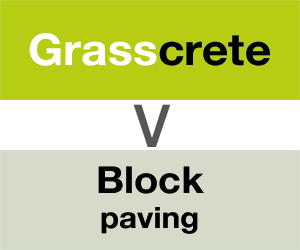Manual handling, lifting and carrying are the most common causes of work-related musculoskeletal disorders (MSDs), with factors such as repetitive work that is carried out in an awkward or tiring position contributing significantly to other causes.
This type of work is commonplace in the construction and building industries, and no matter how much effort is put into designing-out such factors or introducing automation, there will always be tasks that can only be carried out by a human being.
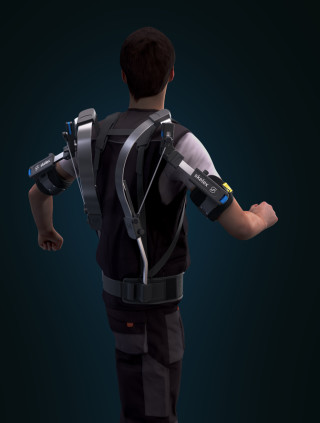
Hence, the development of power-assisted vests or ‘exoskeletons’ that can make carrying out repetitive tasks easier, safer and less tiring is being followed with keen interest by companies in sectors where MSDs are most prevalent. And with no industry standards available, early-adopters are carrying out their own trials to assess whether the products on the market deliver what they promise.
Almost a quarter of all working days lost due to work-related illness in 2017/18 were through MSDs, and they affect an estimated 2.5% of the construction industry workforce. What’s more, the working population is ageing, and as we age we are not able to perform to the same level; the body suffers a reduction in joint mobility, a decrease in muscular strength and the slowing of reaction and movement times.
Giving operatives the chance to boost their productivity and reduce fatigue could also go some way towards reducing the skills shortage by opening up jobs to a wider range of ages and physical abilities, managers believe.
The construction industry has already started embracing the use of personal ‘wearables’ to address specific wellbeing issues – safety on site being one of the most obvious. In the form of tags that can be worn on clothing, or apps on mobile devices, they warn the wearer – and the operator – if they stray within range of plant or equipment.
But exoskeletons are much larger than other wearables – and this is one of their potential drawbacks. They are designed to assist the wearer in carrying out repetitive, heavy or tiring tasks – supporting their limbs either by passive mechanical means such as springs, or with battery-powered help. The weight of these ‘suits’ and the potential for them to get snagged on machinery or materials, or to interfere with other PPE such as fall-arrest harnesses, are some of the issues being cited by those who work in the industry.
Attempts to create such systems date back half a century – in the 1960s General Electric worked with the US military to develop the Hardiman, a powered exoskeleton that could ‘amplify’ human strength by a factor of 25. The aim was to create a machine that could move cargo or equipment, and make a weight of 680kg feel like just 27kg to the wearer. But the system itself was barely wearable, weighing in at almost 750kg, and the project stalled due to the suit’s weight, lack of stability and power supply issues.
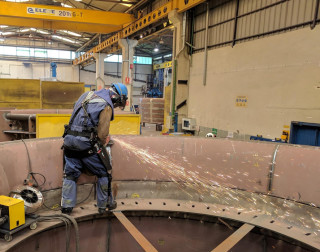
In recent years, interest in exoskeletons has been revived, with modern robotics and materials technology enabling lighter and more responsive systems to be designed. Manufacturers developing systems for military and healthcare applications are tapping into the demand for assistive suits in industry, working with major companies to design and test new products aimed at specific job functions or tasks.
These include vests that assist the user’s arms in lifting and working overhead, a ‘chairless chair’ so that users can ‘sit’ wherever they are, and gloves that boost the grip function and reduce fatigue for operatives doing manual work.
Etienne Burdet, who is professor in human robotics at Imperial College, London, points out that the market for occupational exoskeletons – especially in the automotive industry where the majority of work on a production line is done overhead – is developing very quickly, and agrees that there is a clear need for this type of product.
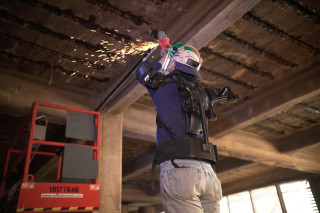
“All the major car manufacturers are working with technology companies to develop something of their own,” says Burdet. The demand for employers to enable staff to continue working as they get older, along with improvements in materials, have given this market a kick-start, he believes. He also notes that it is easier to develop exoskeletons for occupational use than it is for rehabilitation, since the wearer is able-bodied and capable of controlling the movements.
French contractor Eiffage and Swedish specialist Bioservo Technologies started working together in 2017 to develop a so-called ‘bionic glove’ that was launched on the market earlier this year and is claimed to considerably reduce the effort necessary by the wearer.
The Ironhand robotic glove is designed to boost the action of the wearer’s hand and wrist, and is aimed at anyone who uses power tools, as well as trades such as welders, plumbers, steel fixers and so on.
In addition to reducing fatigue and improving productivity, the glove is intended to prevent MSDs caused by manual work as well as assisting people with disabilities in returning to work. It was originally designed for the military and has been used by NASA astronauts, but after trials by Eiffage, a new prototype was designed, with sensors and synthetic joints added, the strength and reaction time increased and ergonomics improved.

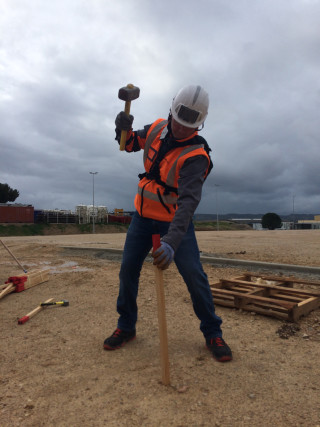
The glove has six sensors – one at the tip of each finger and one on the palm – and has artificial tendons along the fingers that are connected by cable to a power pack on the wearer’s back. When the wearer tightens their grip, the sensors detect this motion and the motors supply extra power to the user. Tests established that the effort needed by the wearer’s hand could be reduced by anything from 25% up to 82%, depending on the task. The glove was launched on the French market earlier this year.
Another joint venture formed in 2017 was between Hong Kong-based contractor Gammon Construction and Atoun, a specialist spin-off from Panasonic, to trial Atoun’s prototype power-assisted suit for bending and lifting on its M+ Building site in Hong Kong. The contractor gave feedback on its use that was fed into improvements in the second-generation version, known as Model Y, and has since purchased three of the new version for its own use.
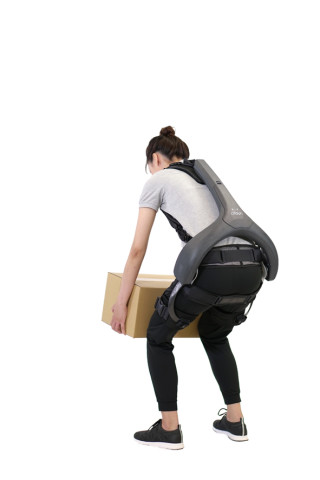
The carbon fibre frame of the Atoun Model Y weighs about 4kg and is worn like a backpack. When a worker is about to pick up a heavy object, the suit senses the movement and goes into operation to provide back support. It switches off while the wearer is walking, and then switches on again as the wearer lowers their burden, acting as a ‘brake’ on the motion. According to the manufacturer, it can reduce strain by as much as 10kg, and consequently lowers the risk of back injuries common among construction workers.
US-based company Ekso Bionics, which started out serving the health and defence industries, has a product for boosting upper-body power that is prompting interest in the construction sector and is being trialled by a number of companies in the UK. The EksoVest is currently being put through its paces by Amey maintenance staff on the Forth Road Bridge in Scotland.
This product uses mechanical means – a set of actuator springs – to provide support for the wearer’s arms via a harness, rather than powered assistance that requires the use of batteries. It can be adapted to fit each user and weighs around 4kg. Again, the prototype was trialled in partnership with a potential end-user – Ford Motor Company in this case – before being rolled out to the market. Morrison Utility Services and Willmott Dixon are also trialling the EksoVest for manual handling and lifting tasks on sites in the UK.
Clearly the weight of such systems is a major consideration for potential users – the goal of giving workers extra power to lift items, or assistance in standing and bending, risks being undermined if to do so means having to carry an extra load.
Hence most exoskeleton manufacturers are developing lightweight products. Manufacturer US Bionics launched its third-generation ShoulderX product as a carbon-fibre frame weighing in at just over 3kg, while Dutch firm Skel-ex claims its lightweight Skelex 360, which weighs in at 2.5kg and is intended for those working with their arms elevated above their head for extended periods, is the lightest product on the market.
Similarly Swiss company Noonee reduced the weight of its Chairless Chair by 25% when it launched its second generation version earlier this year. As the name suggests, the chair enables the wearer to sit without the need for a chair, and supports them in the correct posture as they do so. The height of the ‘chair’ can be adjusted by the wearer to suit the task, and is designed for individuals ranging from 1.5m to 1.9m tall.
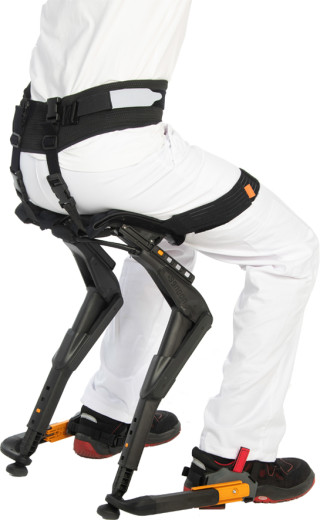
While early-adopters continue to carry out their own tests, the need for industry standards is being acknowledged by bodies such as the ASTM in the US, which has recently formed a committee tasked with investigating the issues. Much of the industry interest in adoption of exoskeletons in the workplace is motivated by injury prevention, but the lack of product standards has been cited as a barrier to their adoption.
As well as weight, the main issues cited are the ease of donning and doffing the apparatus, the potential for restriction of movement, and whether the suits put undue pressure on parts of the body, or have a negative impact on posture. Costs per unit are typically several thousand pounds, hence the investment needed to trial products even on a small scale can be prohibitive.
Nevertheless, a lot of research is being done in this sector at the moment. There is already empirical evidence of the effectiveness of occupational exoskeletons, mostly from lab-based studies but also a few from field studies, although none specific to the construction industry, according to Maury Nussbaum, director of the Occupational Safety & Health Research Center at Virginia Tech in the USA.
While findings showed that the suits are effective in reducing the time taken and effort
needed to carry out certain tasks, such as overhead drilling, researchers also noted a reduction in quality of the work, and the potential for increased pressure on other parts of the upper body. Further research is needed in these areas, Nussbaum believes.
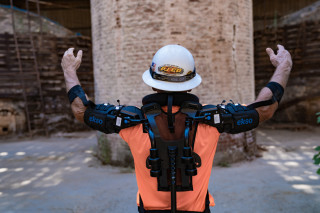
This article was first published in the October 2019 issue of The Construction Index magazine(magazine published online, 25th of each month.)
UK readers can have their own copy of the magazine, in real paper, posted through their letterbox each month by taking out an annual subscription for just £50 a year. Click for details.
Got a story? Email news@theconstructionindex.co.uk


